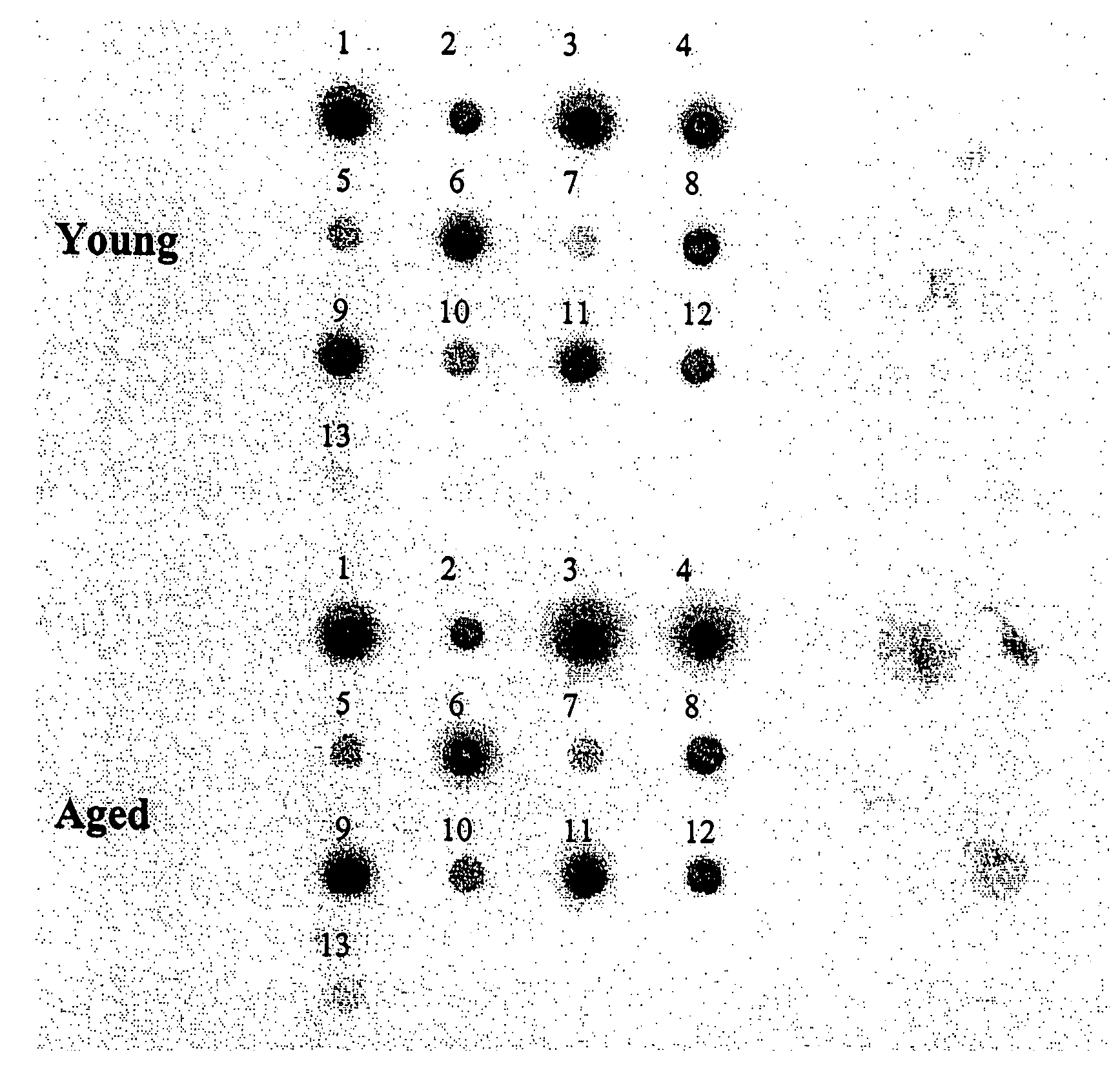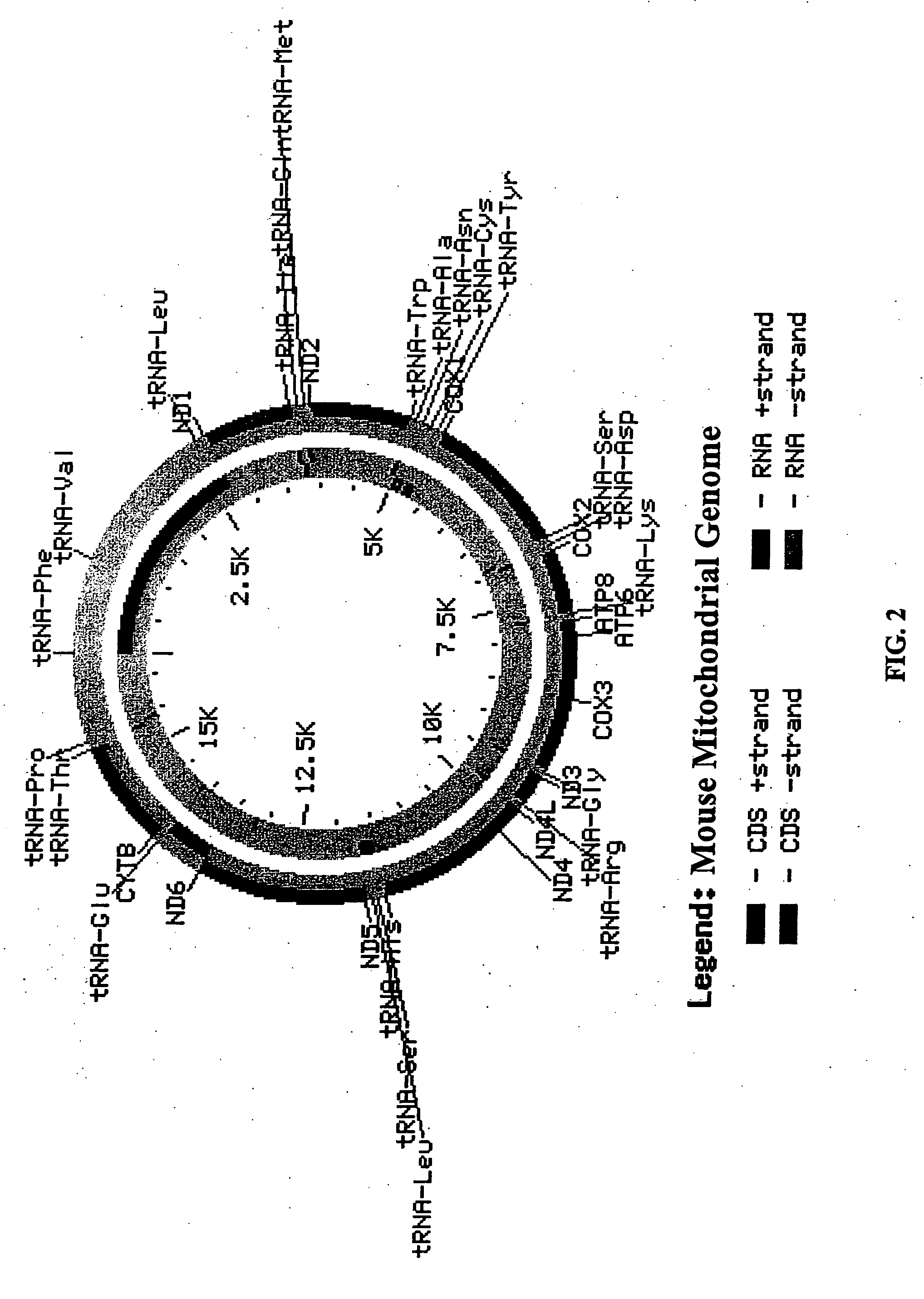Methods and compositions for analysis of mitochondrial-related gene expression
a technology of mitochondrial gene and analysis method, applied in the field of molecular biology and medicine, can solve the problems of affecting the health of patients, so as to reduce the function of mitochondria and reduce the burden on the economy
- Summary
- Abstract
- Description
- Claims
- Application Information
AI Technical Summary
Benefits of technology
Problems solved by technology
Method used
Image
Examples
example 1
Capability and Feasibility Studies
[0115]In order to demonstrate the capability of the present invention, a DNA microarray was generated from PCR products using thirteen genes that code for the mitochondrial proteins (FIG. 1). These genes were attached to nylon membranes by cross linking with UV radiation.
[0116]Positions #1 to #13 on array 1 (young) and array 2 (aged) contain the 13 mitochondrial gene targets. A hybridization study was carried out using samples from young vs aged mouse livers. The samples were labeled by reverse transcriptase incorporation of radiolabeled nucleotides and the results were observed by autoradiography. Intense and specific hybridization signals were detected at all positions indicating levels of transcript abundance.
[0117]The data showed a successful hybridization of a limited set of mitochondrial genes on the test array.
example 2
Location of Mus Musculus and Homo sapiens Mitochondrial Peptides and Proteins
[0118]FIGS. 2 and 3, are maps of the human and mouse (Mus musculus) mitochondrial genomes which show the location of the 13 peptides of the OXPHOS complexes, 22 tRNAs, and 2 rRNAs that are encoded by the mitochondrial genome, and that were used, in part, to prepare an array of the present invention.
[0119]Table 2 shows the location of the Mus Musculus and Homo sapien mitochondrial proteins (13 polypeptides). It gives their location (nucleotides), strand, length of polypeptide (number of amino acids) name of the gene, and the protein products which was used in part as targets for an array of the present invention. Table 3 shows the location of the Mus musculus and Homo sapiens mitochondrial 12S and 16S ribosomal RNAs and 22 tRNA.
example 3
Effects of Rotenone on Expression of Mouse Mitochondria Genes
[0120]The effects of rotenone, an inhibitor of mitochondrial Complex I, on the expression of mouse mitochondrial genes in AML-12 mouse liver cells in culture were examined (FIG. 4; Table 4). The microarrays show the mRNAs whose pool levels are up-regulated. Spots A1-G11 represent mitochondrial related nuclear encoded genes; spots G12-H12 represent the 13 genes encoded by mitochondrial DNA. It should be noted that in subsequent microarray designs (constructions) the mitochondrial DNA encoded genes G12-H12 were removed from the filters and arrayed separately. Thus, the G12-H12 spots were replaced with nuclear encoded genes. The following data suggest that the a number of genes are up-regulated in response to rotenone treatment: A11, ATP synthase lipid binding proteins; B8, ADP, ATP carrier protein; B9, cytochrome C oxidase chain VIIa; D12, chaperonin 10; E12, pyruvate carboxylase; H7, Complex I: Protein Dehydrogenase chain 3...
PUM
| Property | Measurement | Unit |
|---|---|---|
| temperature | aaaaa | aaaaa |
| ionic strength | aaaaa | aaaaa |
| thermal melting point-Tm | aaaaa | aaaaa |
Abstract
Description
Claims
Application Information
 Login to View More
Login to View More - R&D
- Intellectual Property
- Life Sciences
- Materials
- Tech Scout
- Unparalleled Data Quality
- Higher Quality Content
- 60% Fewer Hallucinations
Browse by: Latest US Patents, China's latest patents, Technical Efficacy Thesaurus, Application Domain, Technology Topic, Popular Technical Reports.
© 2025 PatSnap. All rights reserved.Legal|Privacy policy|Modern Slavery Act Transparency Statement|Sitemap|About US| Contact US: help@patsnap.com



